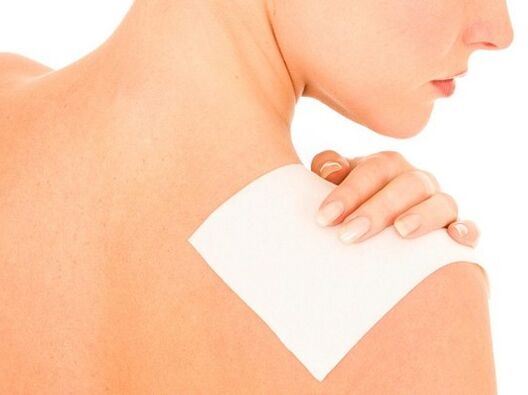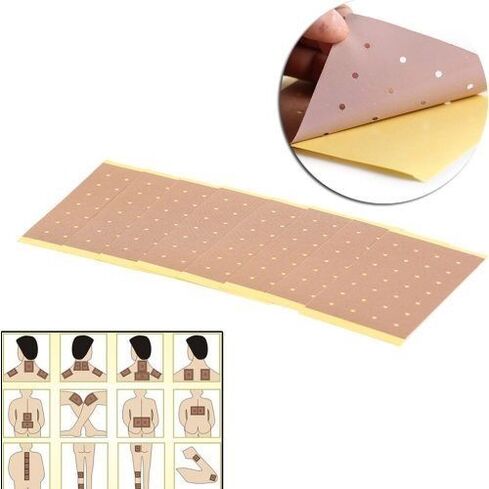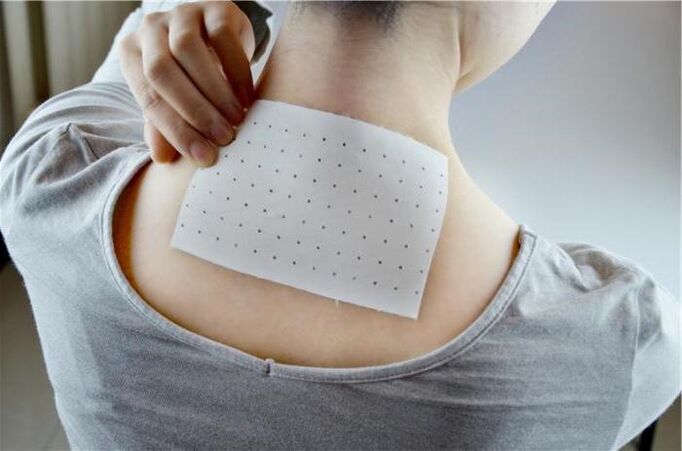
Back pain can occur for various reasons, for example due to strenuous physical activity, sedentary work, injuries and diseases of the spine. To eliminate discomfort, tablets and injections are more often used, but these dosage forms can cause serious side effects. There is a safer treatment method - patches for back pain. These are transdermal active ingredients that are applied to the affected area and slowly release medication there, thereby achieving a long-term therapeutic effect. The use of patches is safer because the amount of active ingredients that enter the blood is minimal. In addition, they are easy and effective to use. However, before buying, you need to know what types of patches there are, when and how they can be used.
Instructions for using plasters
The causes of back pain can be very serious, so you should not try to solve the problem yourself. Visit a doctor who will diagnose and find out the cause of the pain. You can then ask a specialist whether medical patches can be used.
Important!Before using plasters, concomitant illnesses must be ruled out, which can also manifest themselves in back pain. These include diseases of the kidneys, respiratory tract, digestive organs and oncological formations.
Transdermal active ingredients (TC) for the back and joints are used in the following cases:
- Osteochondrosis, which causes pain in the neck, chest or lower back.
- The presence of protrusions (bulging of the intervertebral disc without rupture of the outer shell), hernias (prolapse of the nucleus pulposus between the vertebrae).
- Osteoarthritis or arthritis of the joints.
- Damage to the spinal cord or its roots caused by displaced vertebrae.
- Back pain related to injury, heavy physical work, or prolonged sitting.
- Tense muscles around the spine.
- Compression of spinal nerves etc.
As you can see, plasters are used for inflammatory or degenerative diseases of the spine and joints.
Mechanism of action
Transdermal devices are intended for external use. The patch is stuck to the painful part of the body and releases the medication there in dosed doses. In this way, it helps to relieve pain in the neck, back and bone joints.
The action of TCs is primarily aimed at relieving pain and inflammation and therefore is recommended for use as part of complex therapy. Treating musculoskeletal disorders with patches alone is not effective. And they are ideal as aids.
TS have the following advantages:
- They are compact and convenient to use.
- The patient does not have to determine the dosage himself, as the medicine is administered to him in the correct amount.
- TS acts directly at the site of the lesion.
- The likelihood of side effects is low because the amount of active ingredients that enter the blood is minimal.
- The active ingredients of the patch do not interact with other medicines.

The therapeutic effect of TS is different, but they all consist of several layers:
- Fabric or synthetic base.
- A layer of medicinal substance that softens and is absorbed under the influence of the heat of the human body.
- An adhesive layer that ensures that the patch sticks to the skin.
- Protective film that must be removed before use.
The medical sticker is stuck on the diseased area, the medical layer becomes softer and the medication penetrates deep into the skin and has a therapeutic effect there. The product acts directly on the source of pain and cramps. This method of treatment helps to avoid the negative effects of medications on the gastrointestinal tract and the body as a whole.
Types of therapeutic plasters for back and joints
Depending on the therapeutic effect, the following types of plasters are distinguished:
- Anesthesia.This is a TS based on analgesics or anesthetics that relieve pain. Products containing NSAIDs help reduce pain and inflammation. They are most often used in the acute stage of spinal diseases. TS, the sticky layer of which contains anesthetics, only helps to cope with pain, they have no effect on the cause of its occurrence. The therapeutic effect is achieved by blocking surface receptors. Nanoplastics contain biologically active substances that affect pathological cells. Tiny nanoparticles surround the affected area and relieve unpleasant symptoms.
- OrthopedicThe back plaster contains chondroprotectors. The composition of the healing layer includes chondroitin, which protects the cartilage lining of the vertebrae and joints from damage and accelerates their recovery. They also contain glucosamine, which accelerates the regeneration of cartilage tissue. And thiamine saturates the bone joints with nutrients, restores innervation and improves immunity.
- Phytoplasticscontain extracts of medicinal herbs, essential oils, etc. They accelerate blood circulation and metabolic processes in the damaged area, relieve pain and inflammation. Some products contain magnetic components that accelerate the penetration of active ingredients inside. The therapeutic effect of phytoplasts has not been confirmed by research, however, according to reviews, they are effective.
- Warm up.These TCs contain hot pepper or mustard seed extract. The heat patch improves microcirculation in the blood, stimulates receptors and activates metabolic processes at the site of exposure. These products not only contribute to tissue warming, but also improve its trophism and accelerate regeneration.
- Reflects heat.This group includes therapeutic stickers containing nanopowders made from rare earth metals. They create a magnetic and infrared field on the body that improves blood circulation, relaxes muscles, reduces pain and inflammation, and heals tissues faster. They do not contain active components and are therefore considered the safest.
Reference.Most plasters (with the exception of products with anesthetic) have a complex effect. They accelerate the flow of blood and lymphatic fluid to the sore spot, then inflammation disappears faster, cramped muscles relax, cells are saturated with useful substances and tissue healing accelerates.
To know exactly what type of patch you should use in a particular case, you should consult your doctor.
The best means
The question of which plaster is best for back pain is certainly relevant. This depends on the type of pain, the cause of its occurrence, contraindications, etc. A doctor will help you choose the most appropriate remedy.
The best transdermal products:
- Pepper plaster for back pain is the most popular pharmaceutical remedy. This is a vehicle based on which pepper extract is applied. It has a warming, distracting effect. You need to hold the pepper plaster until the pain disappears and a burning sensation appears. The maximum exposure time is 48 hours. Pepper plasters can be used instead of mustard plasters to warm up the muscles before training, to relieve discomfort after back injuries and also for diseases of the respiratory system. The price of the product depends on the size.
- An anti-inflammatory agent based on a phenylacetic acid derivative. It helps relieve pain and swelling and reduce inflammation. Most often, TS is used for radiculitis, arthrosis and osteochondrosis. The patch must not be left on the back or any other area for more than 24 hours, after which a short break is required. The therapy course lasts approximately 2 weeks.
- A patch based on a propionic acid derivative is also a representative of NSAIDs. The active ingredient slowly penetrates the damaged area and has a therapeutic effect there. This medication can be used twice a day.
- The best Japanese anesthetic plaster. A layer of anesthetic is applied to the substrate. The plaster also helps with severe pain. The therapeutic effect lasts 3 hours. However, this product can suppress nervous reactions and is therefore not recommended for use before activities requiring increased attention and precision.
- The nanopatch contains a layer of tiny particles made of rare earth metals that only affect pathological cells. It is able to warm up and stop inflammation. The sticker is fixed on the back for 12 hours, after which a break is taken. It can be used for 3 to 9 days.
- A plaster based on activated carbon, iron powder and salt has a pronounced warming effect. It relaxes tense muscles and relieves pain. The heat patch lasts for 12 hours, then you need to remove it and treat the skin with moisturizer.
- A phytoplast based on 10 medicinal plants is effective for radiculitis, degenerative changes in the intervertebral discs, osteoarthritis and myalgia (muscle pain). TS stimulates blood circulation, relieves pain, reduces swelling and accelerates regeneration.
A Thai plaster based on camphor, mint oil, eucalyptus, menthol, etc. is also very popular. According to reviews, it helps to relieve or stop back pain within a few minutes.
You can buy all of the medications described above in many pharmacies or on the Internet.
Chinese transdermals
According to reviews of patients who have experienced the effect of Chinese plasters, they help to quickly cope with back pain and rarely cause side effects. A major disadvantage of such products is that there are no clinical studies proving their effectiveness and safety.
Popular Chinese plasters for back pain:
- Plasters with medicinal plant extracts, essential oils, insect poison (scorpions, ants). It quickly relieves inflammation and pain and accelerates tissue recovery in the damaged area. The duration of using a warming compress is about 2 days, after which a break is required. You need to use 6 to 8 patches per course.
- TC based on myrrh and boswellia is also suitable for patients with sensitive skin as it only contains plant substances. Before applying the patch, you must massage the skin for a few minutes. The wearing time is 18 to 36 hours. The treatment can last several weeks.
- The patch is based on an extract of ginger, cinnamon, mint and chili and is equipped with magnets that enhance the effect of medicinal components. Such a plaster develops a therapeutic effect more quickly and brings relief to the patient. The product with magnet can be used for up to 2-3 weeks.
- TC contains about 20 medicinal plants that help quickly relieve inflammation and pain. The therapeutic effect lasts up to 14 hours. The course of treatment can last 15-20 days.
- A plaster based on a whole complex of herbal components, including safflower and Borneo camphor, is good for back pain. According to the manufacturer, the patch slows down degenerative processes in the spine and accelerates the regeneration of damaged tissue. The duration of use is 2 to 3 days, after which a break of 5 hours is required. You can use 5 to 12 patches per course.
All products described above are not certified and therefore unsafe. They can cause allergies because they contain a large amount of bioactive substances. Therefore, doctors recommend avoiding them and instead using safer patches that have been clinically tested.
Precautions
There are some contraindications to using adhesive plaster for back pain:
- Pregnancy, breastfeeding.
- Hypersensitivity to the components of the patch.
- The presence of cracks, scratches, open wounds and inflammation in the affected area.
- Age up to 15 years.
- Infectious diseases in the acute stage.
- Presence of oncological formations in the area of fixation.
- Reduced blood clotting.
In other cases, the use of patches is permitted. However, to avoid negative reactions, it is better to consult a doctor before using TC.
Attention.Plasters with a warming effect cannot be placed on areas of the body where blood vessels are close to the skin. This is due to the risk of burns.
Side effects after using the patches are rare. Some people have experienced local irritation after using TC, but this quickly disappears after removing the product.
Application recommendations
Not all patients know how to use the patch. The instructions for use for them are listed below:
- Before applying the patch, wipe the desired area with an alcohol-based liquid.
- Remove the protective film and stick the healing plate.
- Leave on for the required time and then carefully remove.

As you can see, there is nothing complicated.
But problems often arise when using the vehicle. For example, some patients are interested in whether it is possible to stick a pepper plaster on the spine. If the pain is localized in the alveolar ridge, attach the TS on the sides to the muscles surrounding it.
Attention.Before applying the patch on your back, it is recommended to do an allergy test. To do this, a piece of it is attached to the wrist; if there is no negative reaction after 15-30 minutes, feel free to use it.
The relevant question is how long a vehicle will be kept. The instructions for each patch indicate the recommended time, but it is better to rely on your own feeling. Usually even the pepper device causes discomfort that can be tolerated. If the burning sensation is very severe, remove the product and consult a doctor.
If the pain does not go away after a week of treatment, contact your doctor. A specialist will help you choose a more effective drug.
To easily remove the patch from irritated skin, use water or oil. It's best to lie in the bathtub for a few minutes and then remove the sticker.
Reviews
Most patients are satisfied with the effect of the patches against back pain. They claim that the product helps to quickly eliminate pain and inflammation. Some people complain that they have allergies after using TC.
- "I suffered from back pain for a long time. I tried many ointments and creams, but they worked temporarily or didn't help at all. Then, on the advice of a friend, I bought a nano patch. It did not work immediately, but after completing the course, the pain subsided and motor activity was restored. After the break I plan to take another course. "
- "I have tried many patches to relieve the symptoms of sciatica. And for myself, I have identified several favorites - Japanese anesthetic and pepper plaster. During an exacerbation of the disease, I used an anesthetic-based patch and then applied a warming sticker to improve blood circulation. This treatment allows me to get rid of the pain for a long time. "
- "I often use plasters for back pain, joint pain, headaches and colds. Over the years I have tried many patches, but the most effective ones were the Chinese magnetic patch and the Japanese anesthetic patch. The insect venom-based patch gave me an allergy; A few minutes after fixation, severe burning and irritation occurred. I immediately took the patch off and stopped using it. "
The most important
The patches really help to relieve or completely stop back pain, but for this they must be used as part of complex therapy. There are painkillers, warming, orthopedic and phytoplasty. When choosing a vehicle, you must take into account the diagnosis, age and the presence or absence of contraindications. It is better to leave the choice of medicine to a doctor. The specialist will tell you about the intricacies of its application. Doctors do not recommend using uncertified Chinese plasters, although many people are satisfied with the effect of their use. But in any case, the choice is yours.





































